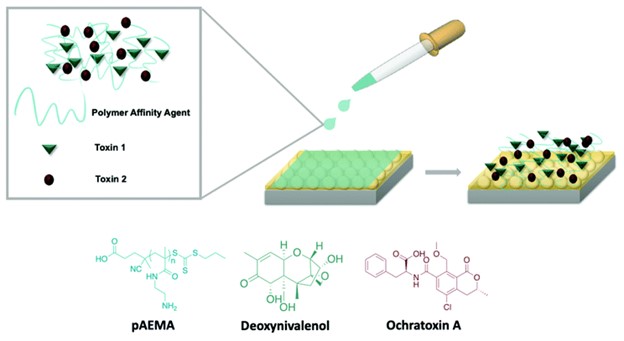Detection of toxic small molecules using polymers and Raman scattering
A method to capture one or more analytes using polymers to enable multiplex quantitative detection by surface-enhanced Raman scattering

Applications
- Food safety testing
Key Differentiators and Benefits
- Facile and inexpensive: by using polymers as affinity agents, which can be easily synthesized and tuned to exploit targeted molecular interactions
- Multiplex detection: manipulating the chain length of the polymer and their functional groups facilitates multiplex capture of an entire class of molecules using a single affinity agent
- Low limits of detection: using surface-enhanced Raman scattering (SERS) allows for low limits of detection to be achieved even in complex matrices
Technology Overview
Mycotoxins are small molecule toxins produced from fungi that contaminate a wide variety of crops. These small molecules can be extremely carcinogenic to humans, posing dangerous hazards in food production and consumption even at low concentrations. Detecting mycotoxins traditionally employs the use of specific affinity agents. These detection methods, however, are expensive, do not offer the opportunity to detect a multitude of toxins in complex matrices, and are often qualitative.
To address this gap, researchers at the University of Minnesota have developed a new method for capturing and detecting small molecule toxin targets such as mycotoxins. This method utilizes linear polymers, with commercially available monomers, as capturing agents for various small molecules. Using surface-enhanced Raman scattering (SERS), a single polymer affinity agent can facilitate multiplex detection of a class of molecules through less-specific interactions than traditional affinity agents. In other words, by providing fingerprint spectra for various targets, one can easily detect more than one target mycotoxin in relevant complex matrices. Lastly, polymer affinity agents exhibit heightened flexibility in solution, thus enabling optimal polymer-target binding that is not achievable when pre-anchored to the substrate.
Phase of Development
TRL: 3-4Proof of concept, showing detection of two different small molecule targets of interest deoxynivalenol and ochratoxin A at concentrations relevant to their regulation limits, which are 1 ppm and 5 ppb respectively.
Desired Partnerships
This technology is now available for:- License
- Sponsored research
- Co-development
Please contact our office to share your business’ needs and learn more.
Researchers
- Christy Haynes, PhD Professor, Chemistry
- Theresa Reineke, PhD Professor, Chemistry
-
expand_more library_books References (1)
- Rodriguez, R.S., Szlag, V.M., Reineke, T.M. and Haynes, C.L. , Multiplex surface-enhanced Raman scattering detection of deoxynivalenol and ochratoxin A with a linear polymer affinity agent
-
expand_more cloud_download Supporting documents (1)Product brochureDetection of toxic small molecules using polymers and Raman scattering.pdf